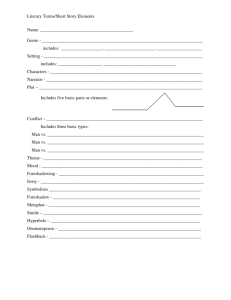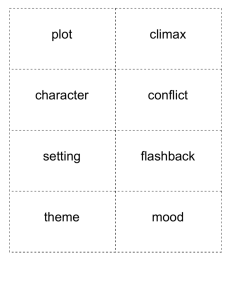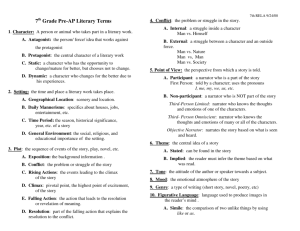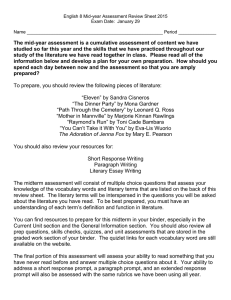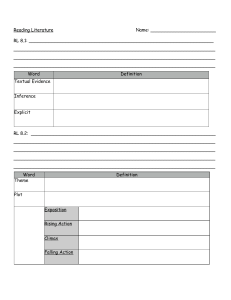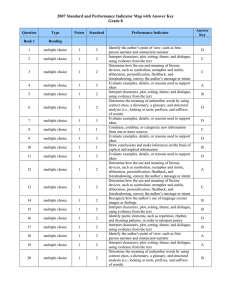Literary Elements Notes
advertisement
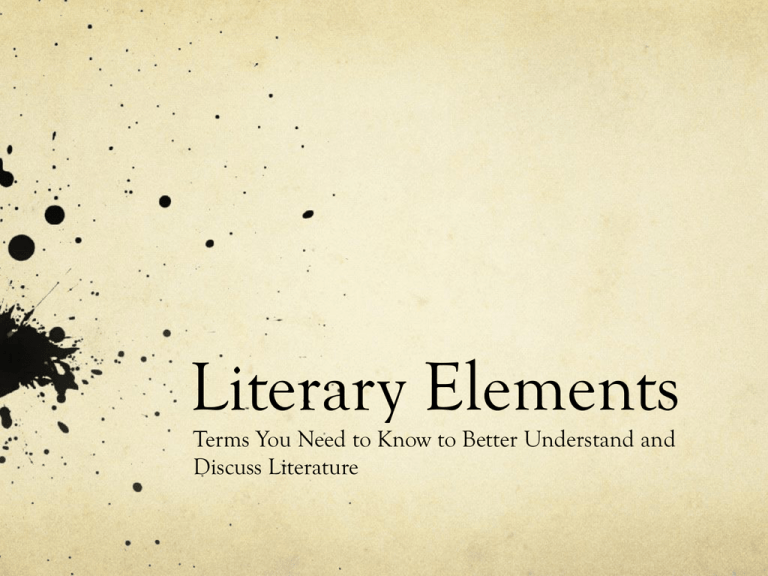
Literary Elements Terms You Need to Know to Better Understand and Discuss Literature Conflict Conflict: the struggle between opposing forces External Types Character vs. Character Character vs. Nature Character vs. Society Internal Types character vs. Self Character Antagonist a character working against the progress of the story. Works against solving the conflict Protagonist a character working forward in the progress of the story. Works for solving the conflict Flat or Static a character who stays the same and has little depth Dynamic or Round a character who grows or changes throughout the story Characterization Characterization: how an author tells readers about a character May be direct, such as descriptions of characters May be indirect, such as learning about a character’s attitude through his/her interactions with others Narrator and Point of View Narrator: speaker or character who tells a story First Person Point of View Told from character using “I” pronouns Third Person Limited Point of View Told from one character observing others and using “he/she/they” pronouns Third Person Omniscient Point of View Told from an all-knowing narrator who knows and tells about what each character feels and thinks Second person- Narrator use pronoun “you” when telling story Least used in literature Foreshadowing & Flashback Foreshadowing: when an author gives tips and clues to events later in the story Flashback: when the story goes back in time to provide readers with additional background information Plot Elements Exposition: introduces the setting, characters, and basic situation Inciting incident: conflict is introduced Rising Action: central conflict is developed Climax: highest point of interest or suspense (“last battle”) Falling Action: last elements of the central conflict Resolution: ending when all loose ends are tied up Setting Setting: time and place of the action Includes time, place, and social environment Year, time of day, weather Country, state, region, community, or neighborhood Dialect, clothing, customs, and transportation Often sets the mood or feeling of the story Theme Theme: central message, concern, or purpose of a literary work Often a general statement about people or life Usually not stated directly, instead readers must look carefully at what the literary work reveals about people or life Dialogue Dialogue: a conversation between characters Usually set off with quotation marks Punctuation of dialogue has specific rules Dialogue in drama follows the names of the characters and does not include quotation marks Figurative Language/Figures of Speech Simile Comparison of two unlike things using like or as Metaphor Comparison of two unlike things, saying one thing is something else Personification Nonhuman thing is given human characteristics Alliteration Repetition of beginning consonant sounds Figurative Language/Figures of Speech cont. Hyperbole Exaggeration for effect, not to be taken literally Onomatopoeia Use of words that imitate sounds Oxymoron Apparently contradictory terms appear together Dramatic Irony When the audience knows something the characters in the story do not know Imagery/Sensory Language Imagery and Sensory Language Words or phrases that appeal to one or more of the five senses Provides more detailed reading experiences Look, sound, feel, taste, and smell
